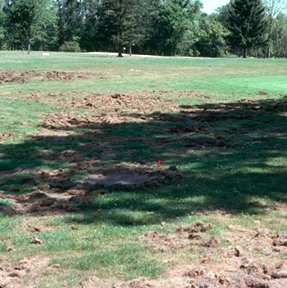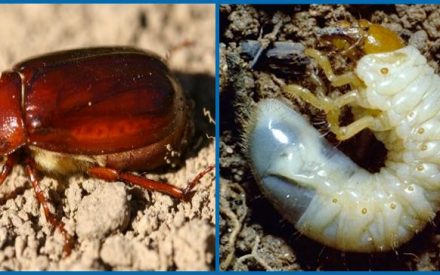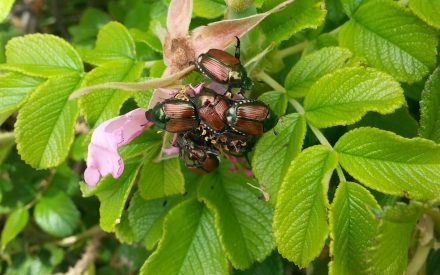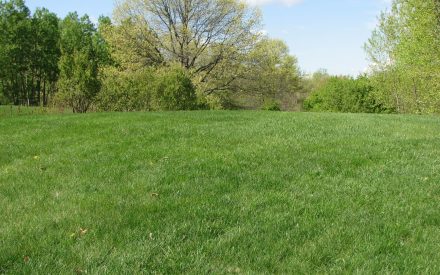Authors: PJ Liesch and Vijai Pandian, UW-Madison Extension
Last Revised: 11/19/2020
X-number: XHT1018
Several species of white grubs are considered turfgrass pests in the Midwest. These grubs are the larval stages of scarab beetles such as Japanese Beetles, May/June Beetles, European Chafers, and Northern Masked Chafers.

White grubs have pale, C-shaped bodies, orange heads and three pairs of legs. They can vary in size from less than ¼ inch long to over one inch long depending on the species and their stage of development. White grubs live in the root zone of turf and have chewing mouthparts that they use to feed on plant roots. Most turfgrass areas in Wisconsin have white grubs but typically in low numbers that cause minimal damage. When grubs are abundant however, they can cause significant damage leading to irregular brownish patches of turf. Additional damage can occur when animals (e.g., skunks, raccoons, crows, etc.) dig into the turf to feed on the grubs.
Control of white grubs can involve use of non-chemical, chemical and biological methods or a combination of methods.
Non-Chemical Control
Water and fertilize turfgrass areas optimally to help them tolerate white grub feeding. In addition, be sure to mow at the correct height and at the correct frequency to encourage deep root growth. Finally, be sure to properly reseed damaged areas as needed. See University of Wisconsin-Madison Extension bulletins A3950 (Watering Your Lawn), A2303 (Lawn Fertilization), A3435 (Lawn Maintenance) and A3434 (Lawn Establishment & Renovation) for details on these aspects of turfgrass maintenance.
Chemical Control
Consider using insecticides in turfgrass settings where there are existing or anticipated high grub populations, and in settings (e.g., golf courses, sports fields, etc.) where tolerance for grub damage is low. There are two approaches to chemical control: preventative control and curative control. Preventative insecticides provide long-lasting protection. They are most effective against small grubs but in many cases work poorly against large grubs. Preventative insecticides must be applied prior to any egg-laying to achieve maximum effectiveness. Curative insecticides only work for a short period of time and are used when grubs are present and actively damaging turfgrass. See the tables below for available products and their timings of application.
Both granular and liquid formulations of white grub chemical insecticides are available. For all products, you must apply approximately ½ inch of water at the time of application to wash the insecticide into the turf root zone where grubs are actively feeding. Applying water maximizes the effectiveness of the insecticide. If you do not water, the insecticide may provide little or no control.
Note that neonicotinoid insecticides used for grub control can pose risks to bees and other pollinators. See University of Wisconsin-Madison Extension bulletin A4128 (Conservation of Native and Domestic Pollinators in Managed Turfgrass Landscapes) for guidance on protecting pollinators in turfgrass areas.
Biological Control
Biological insecticides available for grub control include Bacillus thuringiensis galleriae (grubGONE! G), Metarhizium anisopliae (Met 52), Paenibacillus popilliae (Milky Spore) and Heterorhabditis bacteriphora (Nemaseek). Consult product labels for application instructions and timing. These products often provide limited and highly variable control compared to chemical insecticides. In particular, Paenibacillus popilliae has not been found to be effective for white grub control in recent university research.
Insecticides to manage white grubs in lawn and turfgrass
| Active Ingredient | Trade Name Examples | Insecticide Class | Approach |
| Carbaryl | — | Carbamate | Curative |
| Chlorantraniliprole | Acelepryn, Scotts GrubEx | Diamide | Preventative |
| Cyantraniliprole | Ference | Diamide | Preventative |
| Clothianidin | Arena and others | Neonicotinoid | Preventative + Curative |
| Dinotefuran | Zylam | Neonicotinoid | Preventative |
| Imidacloprid | Merit and others | Neonicotinoid | Preventative |
| Thiamethoxam | Meridian and others | Neonicotinoid | Preventative + Curative |
| Trichlorfon | Dylox | Organophosphate | Curative |
Proper timing is important to maximize the effectiveness of grub control products. Treatment timing can vary by white grub species.
Insecticide application timing by white grub species
| Species | Preventative Approach | Curative Approach* |
| Japanese beetle | June – July | August – October |
| May/June beetle | May – Early June | July – September |
| European Chafer | May – Late July | August – October |
| Northern Masked Chafer | May – Late July | August – October |
*Curative treatments are most effective against smaller grubs towards the beginning of the treatment window
For more information on white grub control
- Japanese Beetle
- Turfgrass Disorder: White Grubs
- Managing Turfgrass Pests in Wisconsin
- Conservation of Native and Domestic Pollinators in Managed Turfgrass Landscapes
- Northern Masked Chafer
- European Chafer
- Watering Your Lawn, Lawn Fertilization
- Lawn Maintenance
- Lawn Establishment and Renovation
- Turf Management website
Download Article





 May/June Beetles
May/June Beetles Japanese Beetle
Japanese Beetle White Grubs on Christmas Trees
White Grubs on Christmas Trees Home Turf Insecticides
Home Turf Insecticides


